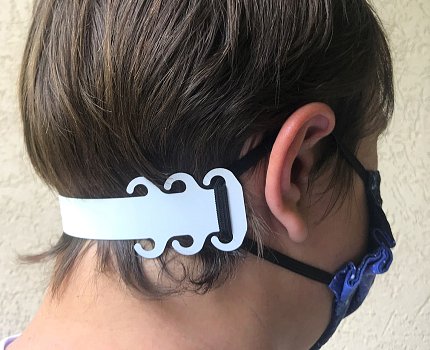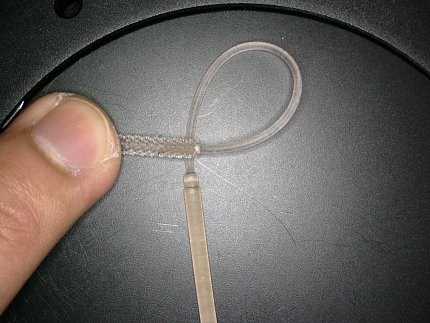CIT Produces Ear Savers, Nasal Swabs for NIH’ers
As the Covid-19 global pandemic continues, testing and protection for health care workers and support staff remain critical in responding to the crisis. To support these efforts, the Center for Information Technology’s signal processing and instrumentation section (SPIS)—a central NIH bioengineering resource that provides custom engineering solutions and in-house fabrication for NIH Intramural Research Program projects—turned their experience in rapid prototyping, novel instrumentation design and software development toward devising tools and equipment that could help.
Two results of their creative work are the design and production of ear savers that help alleviate discomfort from wearing disposable face masks and in-house production and evaluation of 3-D-printed nasal swabs to use for Covid-19 testing.
Face Mask Ear Savers

Ear savers may not seem like important equipment, but they can make a difference in comfort and safety for health care workers. Clinical Center staff—in particular nurses working 8-hour shifts or longer—are required to wear surgical or disposable face masks throughout their shifts for protection. Friction from mask straps can cause irritation and even abrasions to ears when worn for long periods over consecutive days, which can make nurses’ already difficult work more challenging. To provide more comfort and safety to medical staff, the SPIS team created ear saver straps designed to relieve painful chafing and irritation from prolonged wear of disposable face masks.
SPIS set out to design a reusable, quickly produced and cost-effective ear saver device that could be cleaned with common supplies. While the most common ear saver designs include features that require fabrication using widely available 3-D-printing technologies, the team focused on designs that could be laser-cut from acrylic sheets.
This approach offered several advantages: bulk acrylic sheet costs less than 3-D printer materials; using this material means the ear saver can be more easily disinfected; and laser cutting offers a much faster production rate than 3-D printing.
The SPIS team chose a two-dimensional design that included multiple hooks for size adjustment. When testing the available acrylic to find something that could conform to the back of the head without being uncomfortable or too brittle and prone to breaking, the team discovered that acrylic left over from a previous IRP scientific collaboration performed the best due to its thickness. The material was flexible enough to improve comfort significantly but still durable enough to withstand the tension of mask straps.
Due to the limited on-site staff available to help evaluate the fit and comfort of the ear saver, an SPIS engineer asked his wife to try the device at home. This revealed a problem they had not previously considered: the hook configuration of the original design could get caught in long hair. To help prevent this issue, the team developed a new design with an alternate hook shape and a long rectangular back. They called the new design the Tsunami Ear Saver, named after the shape of the strap hooks. The straps are available in two configurations to accommodate different head sizes. This design allows the strap to conform with the back of the head and eliminates pressure points while the hook design reduces the chance of hair tangles.
Robert Reff, a nurse at the Clinical Center who usually works 12-hour shifts, was an early adopter of the Tsunami Ear Saver and quickly became a fan. “The ear savers work great for me because I no longer have any ear pain after wearing masks for extended periods of time,” he says. “The ear saver works great with the combination of the KN95 [mask] and the cloth mask on top because they are both held by the ear saver. Before, they both would sometimes slide off my ear because two masks around my ears created a lot of pressure and bent my ears forward and made the masks slide off.”
Reff is not alone, as several groups of Clinical Center nurses are interested in the Tsunami Ear Saver and have even asked for different versions of the design. SPIS hopes their device will also prove useful for other NIH employees when they begin to return to physical workspaces and are required to wear masks.
3-D-Printed Nasal Swabs
Testing is key to gathering data that informs responses to the pandemic, and testing can only be done with the appropriate equipment. To help find solutions to covid-related problems like localized shortages of certain medical supplies, the SPIS team started a general knowledge-sharing exchange with its long-time intramural and extramural collaborators.

Aware that Children’s National Hospital in Washington, D.C., was concerned about a possible shortage of nasal swabs for testing, the team shared the design of a 3-D-printable nasopharyngeal swab developed by the University of South Florida in collaboration with Formlabs and Northwell Health. Because Children’s was not equipped to print the swab in its own labs, the SPIS team offered to work with them in evaluating these new 3-D-printable swabs for potential use at the hospital.
A thorough evaluation and approval of the swabs by hospital staff was especially important because 3-D-printed swabs are distinctly different in size, shape, flexibility and texture from the normal FDA-approved swabs commonly used. This can be a concern for patient comfort, especially in children, and the fact that 3-D-printed swabs look markedly different from normal ones can deter medical staff and patients from using them.
To give Children’s staff the opportunity to physically handle the swabs and become familiar with the design, the SPIS team printed several dozen swabs and asked the hospital’s laboratory pathology and sample collection staff to examine them and provide feedback on how the swabs’ physical properties might affect their work with patients.
SPIS was specifically concerned about the safety and durability of the 3-D-printed materials. To assess whether the material might be brittle and prone to breaking, the evaluation included performing mechanical testing to determine conditions under which the swabs might break. This involves twisting and bending the swabs well beyond what would happen in actual patient use to identify any weak points. Children’s laboratory personnel were also concerned about possible interactions between testing reagents and the 3-D-printed materials that could affect virological analysis results. Each organization that prints the swabs is encouraged to perform its own evaluations, and SPIS is coordinating with other stakeholders during the testing process.
To be ready for a possible resurgence of the virus this winter, SPIS worked with staff from the Children’s National Hospital biomedical engineering team and the Walter Reed National Military Medical Center’s 3-D Medical Applications Center on evaluating the swabs and manufacturing requirements, to help develop the required regulatory and process controls, documentation and safety testing needed for consistent and safe production of the swabs. If rapid production of swabs becomes necessary in the future to alleviate shortages, the ongoing collaborative preparations will facilitate NIH swab production.
Confronted by this pandemic, the CIT SPIS team developed practical solutions for frontline health care workers by expanding its collaborative work and quickly reorienting its members’ engineering knowledge and experience toward the new problems posed by Covid-19.
“The team’s flexibility and creativity in approaching our community’s needs is just one of many examples of the larger NIH Intramural Research Program’s rapid response to this pandemic,” said Dr. Andy Baxevanis, CIT’s acting scientific director and director of computational biology for the IRP. “NIH’s approach of fostering interdisciplinary, cross-IC technology groups such as the SPIS team allows the IRP to quickly address emerging global health challenges through many different approaches. You never know what solution, big or small, the minds at NIH might think of next, once given the challenge.”
